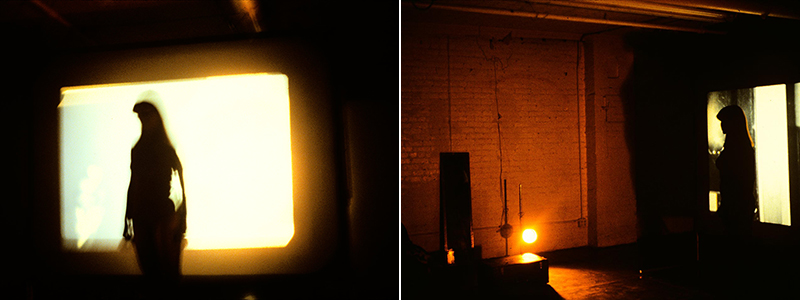

Fly By Night
Fly By Night was a one-night only performance done at Franklin Furnace in early 1983 in what O’Grady later characterized as “a state of physical and psychological exhaustion.” In the two and a half years prior, beginning mid-1980, she had produced three major performances — Mlle Bourgeoise Noire, Nefertiti/Devonia Evangeline, and Rivers, First Draft.
Fly By Night was an unresolved piece which had to be created too quickly. While working on it, O’Grady was already in production on two new Mlle Bourgeoise Noire pieces to extend the persona’s argument: The Black and White Show, a conceptual art exhibit, and Art Is…, a social-practice performance, both 1983. She questioned her wisdom in having accepted a commission for new work at that time.
After doing the performance, she felt briefly embarrassed by it, then forgot about it as she went on to other things — until 2015 when Franklin Furnace asked O’Grady’s permission to include the piece in a collection entitled “Franklin Furnace: Performance and Politics.” The organization sent documentation to her, including slides which she had never before seen.
At first, the documentation was confusing. Though the performance contained imagery from Mlle Bourgeoise Noire, the piece was clearly not about MBN, it was about Lorraine.
Now she recalled that while making Fly By Night, she had believed that in the character of Mlle Bourgeoise Noire, she’d created a stronger, more competent persona than she herself could be.
O’Grady often remarked that she’d taken an “MFA in performance” at Franklin Furnace in the years 1978-80, sitting alone in the back row two nights a week. Performing at the Furnace in 1983 had seemed a safe space to explore her feelings.
Fly By Night turned into a chaotic pantomime performance in blackface without sound. Projected behind the action were rolls of slides that her assistant, Andrew Nahem, the Ringmaster, had shot to incrementally degrade the image of Mlle Bourgeoise Noire. Onscreen, MBN faded to white. Off-screen, Lorraine, wearing black leotards, became tangled in three clotheslines — one each hung with white gloves, white chrysanthemums, and stainless steel cutlery.
At the time, O’Grady realized that Fly By Night had taught her how difficult it would be to make consistently relevant art. But the work’s seeming lack of rigor, even of meaning, appeared reason to disown it.
As she worked on a new slide layout for Franklin Furnace, she began to wonder if the opaqueness of the performance, its incomplete form, might not intimate strength. Though Fly By Night was still an unsolved mystery, it could be better as a puzzle than it had been as a piece. A one-night-only performance, it would still be only partially comprehensible. But having left viewers free to fill in their own thoughts, to connect the dots as they will, the piece now appeared emblematic of the tensions it contained. Itself a remain, it could be an argument for experiment and failure.
